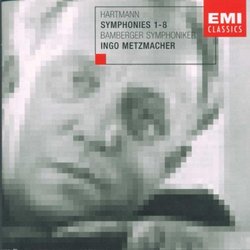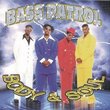| All Artists: Karl Amadeus Hartmann, Ingo Metzmacher, Bamberg Symphony Orchestra, Arno Bornkamp Title: Hartmann: Symphonies Nos. 1-8 Members Wishing: 0 Total Copies: 0 Label: Angel Records Release Date: 11/5/2002 Album Type: Box set, Import Genre: Classical Styles: Historical Periods, Modern, 20th, & 21st Century, Symphonies Number of Discs: 3 SwapaCD Credits: 3 UPC: 724355691125 |
Search - Karl Amadeus Hartmann, Ingo Metzmacher, Bamberg Symphony Orchestra :: Hartmann: Symphonies Nos. 1-8
 | Karl Amadeus Hartmann, Ingo Metzmacher, Bamberg Symphony Orchestra Hartmann: Symphonies Nos. 1-8 Genre: Classical
|
Larger Image |
CD DetailsSimilar CDs
|
CD ReviewsLittle known but masterful symphonic music Dr. Christopher Coleman | HONG KONG | 10/19/2001 (5 out of 5 stars) "This three CD collection contains the complete symphonic works of a relatively unknown german composer, Karl Amadeus Hartmann performed gloriously by the Bamberg Symphony under the direction of Ingo Metzmacher. Metzmacher has made a name for himself as a champion of newer music, particularly that of his fellow Europeans. Here he provides us with sparkling performances of a composer that few of us would otherwise ever know. Hartmann was born in 1905 and died in 1963, living in Munich all his life. He withdrew from musical life in Germany during the Third Reich, but became rather well known abroad as a critic of the Nazi regime. His music ranges widely, from Mahlerian romanticism to German expressionism to Stravinsky-esque neo-classicism, and it is well worth getting to know. For example, the first movement of Hartmann's 6th Symphony (composed between 1951-53) is very stirring music indeed! Why Hartmann has failed to become more well known is a mystery--perhaps it is that his works are so stylistically varied that it is impossible to put him into a single category, perhaps that he never taught or attempted to establish a circle in the manner of Schoenberg, perhaps that his works written before and during World War II were extensively revised following the war. At that time, Hartmann removed all political contexts such as titles and dedications from them, undoubtedly wanting to move from a reputation earned as an Anti-Nazi composer to an apolitical reputation as a good or even great composer. He certainly deserved it, but perhaps Hartmann's problem, although he was an excellent composer, was simply that he was not an innovator in an age that increasingly valued concept above craft. Even though his work is stylistically diverse and in fact writers on his music make much of the influence of the baroque on his pieces, it seems to me that the listener will be more readily aware of the influence of the Romantic Period. Hartmann's music is very expressive and stems from a well developed sense of pitch, coupled with romantic ideas of dynamics, texture and phrasing, and a stunning knowledge of the orchestra, particularly the percussion section. True, the melodies are not often romantic in nature, but the flavor of the music owes everything to the music of Wagner and Mahler--the relationships of consonance to dissonance, the long phrasing, the sense of harmonic rhythm, the orchestral colors.Hartmann actually took lessons from Webern in 1941-42, but Webern's influence must have been more structural than surface. While occasional arithmetical rows are used to establish rhythms in his Sixth Symphony, the listener is never aware of the process, and certainly Webern's devastatingly thin textures and fragmented melodic elements have no counterpart in Hartmann's music. Instead, what must have attracted Hartmann was Webern's vast contrapuntal knowledge, and indeed Hartmann uses imitative forms such as fugue, canon, crab-canon or mirror-canon extensively. The 5th symphony shows Hartmann at his least Webernesque--even though it was written only 8 years after his studies with Webern, and is only his second piece after those studies. It is scarcely conceivable that this music came from a student of the Second Viennese School--it bears an uncanny resemblance to Stravinsky. This symphony is Hartmann's unidentified hommage to Stravinsky--listen to the opening of the second movement and notice its extremely close resemblance to the opening melodic figure of the Rite of Spring.In the space I have it is impossible to fully discuss all eight works--certainly the first Symphony, with its setting of texts by Walt Whitman, is worth an entire review by itself. This piece, originally composed in 1935-36 and later revised, is quite haunting--an absolute contrast to the music I've mentioned. If Gorecki's Symphony #3 is the Symphony of Sorrowful Songs, then Hartmann's Symphony #1 is its worthy predecessor--a symphony of Horror-ful songs, filled with the immediate shock of loss before the resignation of acceptance. And the second symphony is worth of note, too, with its unusual plantive baritone saxophone solo. This is a fascinating collection, and I'm grateful to Maestro Metzmacher and EMI for making all of Hartmann's symphonies available to us." Great works, but the other set is FAR better! Dr. Christopher Coleman | 11/01/2002 (2 out of 5 stars) "I must warn you! Metzmacher is a weak, tentative, and cautious conductor, intent on keeping everything in perfect balance with all the rage and pain under control - everything "tasteful." In Hartmann!!! The resulting performances will have you screaming at the speakers in frustration if you are familiar with the much more powerful and wildly passionate renditions in the Wergo set. In comparison to Macal, Leitner, and Kubelik, Metzmacher is pale and tepid. Since these, along with those of Havergal Brian, are among the very greatest of the 20th century symphonies, one might not realize what was missing without having heard the Wergo set. But, believe me, it's worth the extra dollars to find out!" A collection of fascinating symphonies Evan Wilson | Cambridge, MA | 05/13/2003 (4 out of 5 stars) "Hartmann's 8 symphonies are among the few pieces that make sense out of the expressionist ethos first propagated by Arnold Schoenberg in pieces like "Verklarte Nacht." While this music is intensely chromatic, Hartmann never assails us with unfocused dissonance for the sake of dissonance. And, because he sticks to established forms (like fugues and variations), his music never descends into incoherent mush the way much of Schoenberg's later music does.Instead, Hartmann provides an intense, frequently tragic ethos based on thematic material that is constantly evolving. Clear themes are more evident in the earlier symphonies, but the remain recognizable figures in the later works. In addition to Schoenberg, there are clear echoes of Hindemith (in the 5th symphony) and Stravinsky (in the single movement 2nd Symphony especially, which sounds like a glyph on the opening to Igor's "Rite of Spring." Overall, this is quite memorable music, though there are places where Hartmann rambles on too long and some stretches where one wishes he's lighten up a little.As for these performances, I think the reviewer who complained about them being too tepid has a point. Metzmacher clearly reins in his forces in some places where wild abandon is needed. Partially, I think this reflects and orchestra that is taxed to its limits. However, there is a stiffness to Metzmacher's phrasing that lends a bland sameness to movements that have more variety then he finds. All that said, there is a distinct advantage to the clarity Metzmacher brings to this complex music. I haven't heard the Wergo set, but I'll bet that the "wildly passionate" playing on that set can get wearing at times if there is limited contrast. So, I guess you'll have to decide what type person you are. Ask yourself: Do I like Haitink or Bernstein (on DG) to conduct my Mahler? If you like Haitink's musicality, go with Metzmacher. If you want Bernstein's wayward passion, then the Wergo set might be your cup of tea. For me, the Metzmacher is fine, though if Kubelik's DG versions of a few of these return, I'll probably invest for times I want to let my hair down and really feel depressed."
|

 Track Listings (8) - Disc #1
Track Listings (8) - Disc #1



